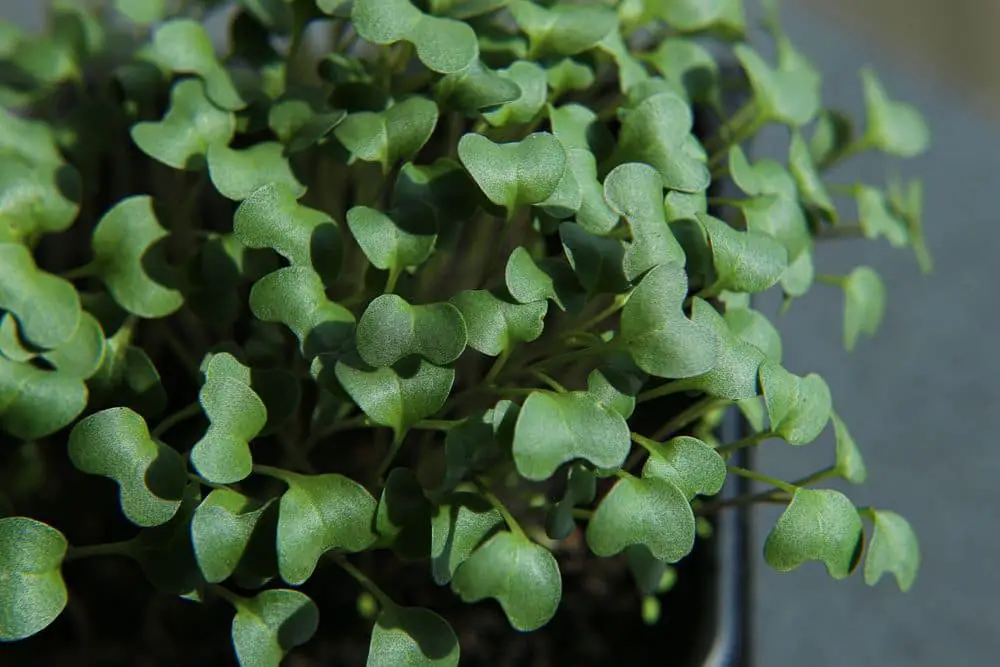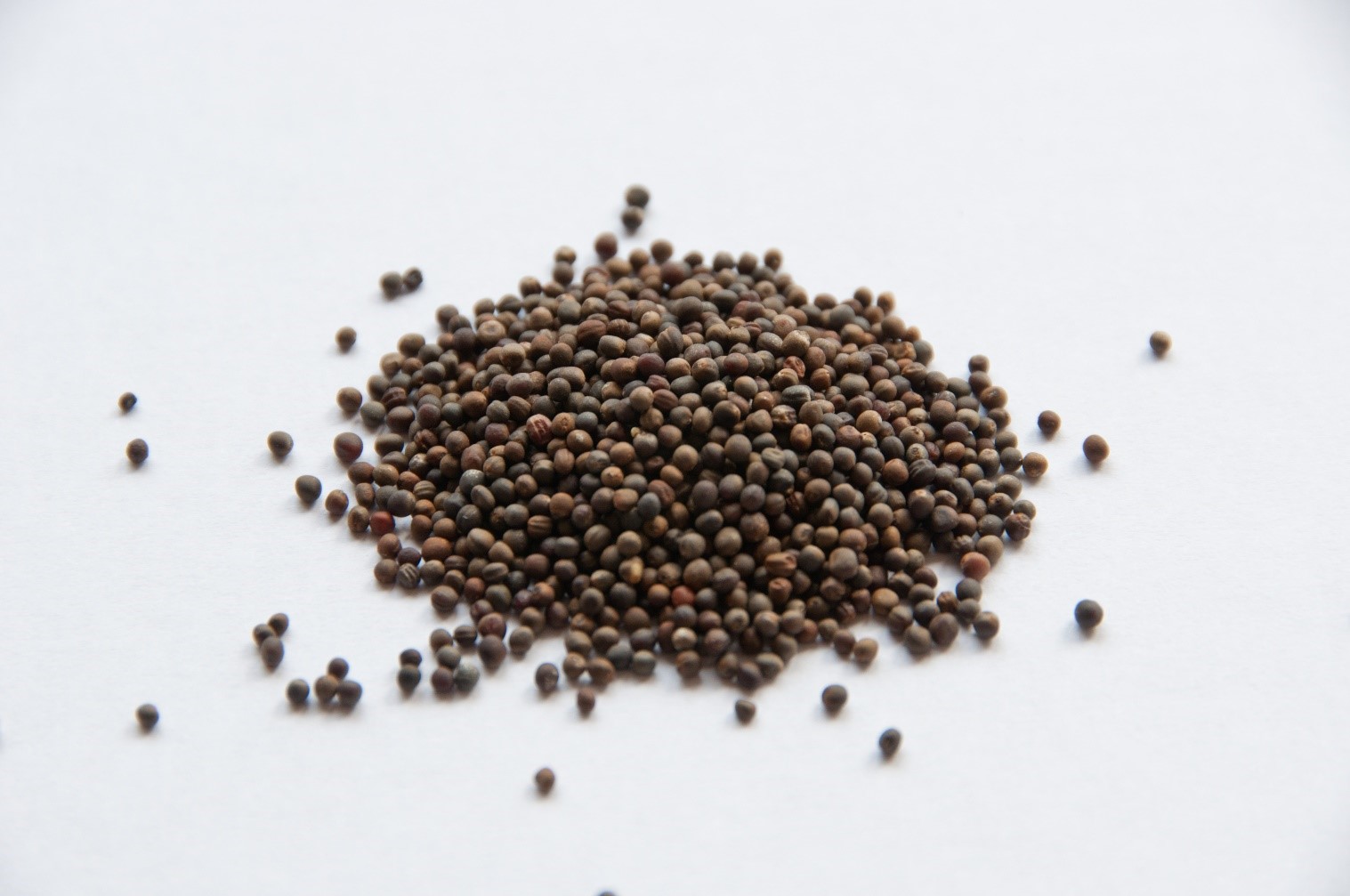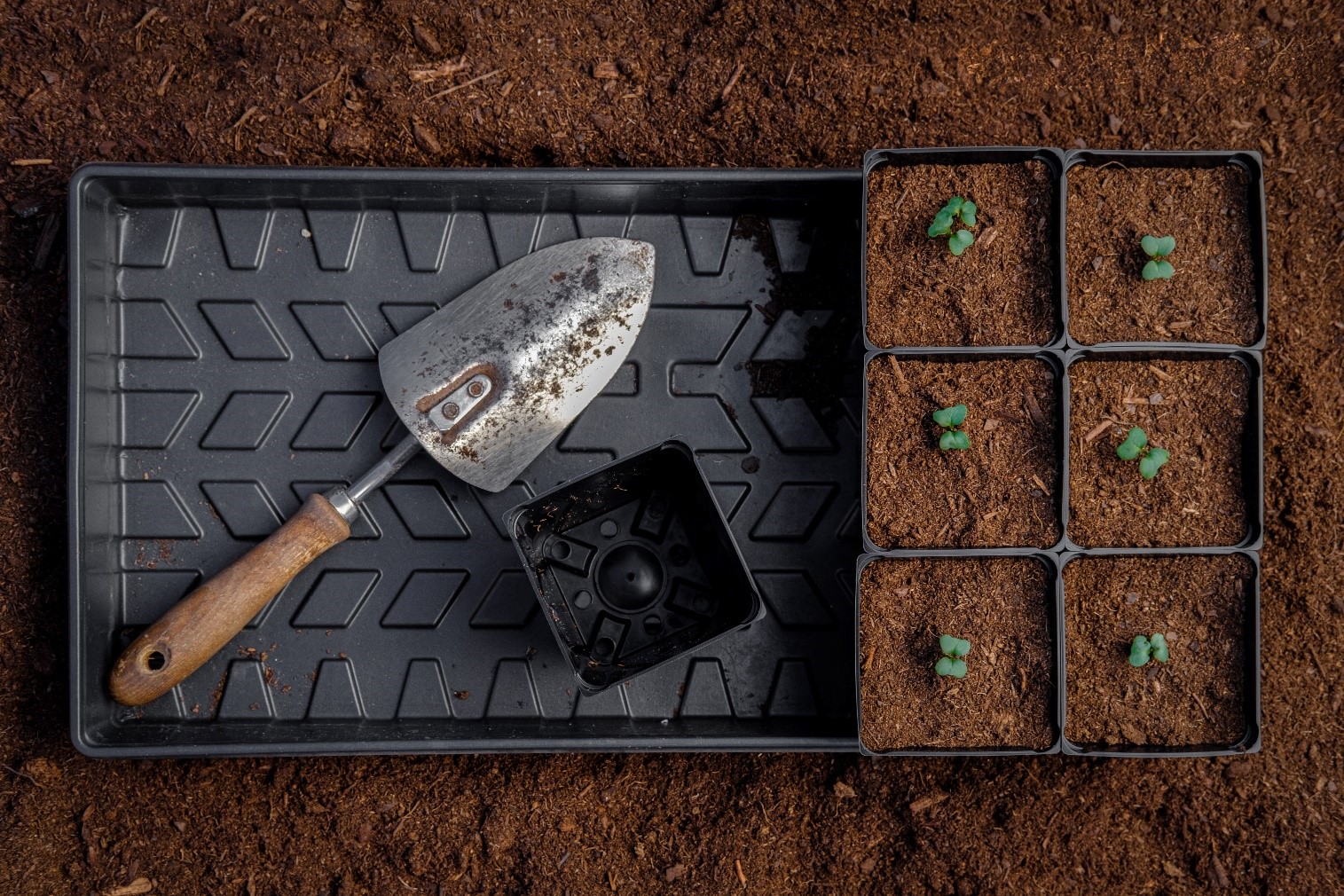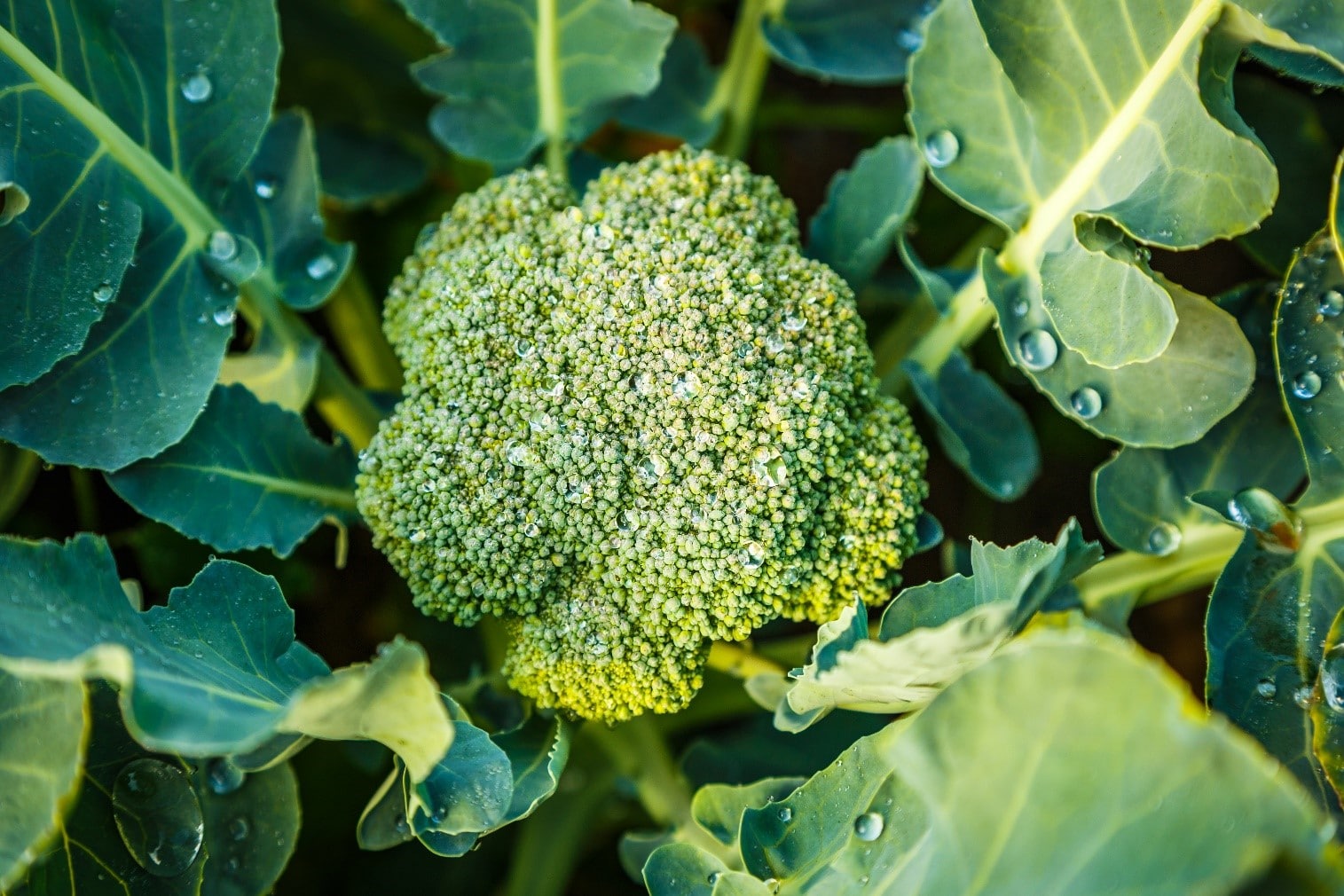How to Grow Broccoli in Containers in 10 Easy Steps
There is nothing so satisfying than enjoying eating the broccoli you’ve personally grown.
Broccoli is one of the vegetables that look and taste better when grown in a garden or container. It’s also fresher (and cheaper) than any broccoli you can buy in the supermarket.

Container growing for vegetables is the perfect answer when you don’t have enough space at your home for a garden! Broccoli is one of the best vegetables to grow in a container.
The broccoli plant is a relative of the Brassica family. Its closest relation is the cabbage, but it is also related to the cauliflower and the brussel sprout – known as cruciferous vegetables.
Nutritional Value of Broccoli
Broccoli is a nutritious vegetable that produces light green stems with large dark green flowering heads. It looks similar to cauliflower because they both come from the same family. Broccoli, however, is of a different cultivar group.
vegetable that produces light green stems with large dark green flowering heads. It looks similar to cauliflower because they both come from the same family. Broccoli, however, is of a different cultivar group.
Broccoli is full of essential vitamins and nutrients, including:
• Iron
• Fiber
• Potassium
• Protein
• Vitamin C
• Vitamin K
It contains more protein than other vegetables. A cup of raw broccoli contains:
• Protein – 2.5 grams
• Fiber – 2.4 grams
• Carbohydrates – 6 grams
• Fats – 0.4 grams
• Sugar – 1.5 grams
• Calories – 31
A great benefit is that broccoli can be included as an ingredient in various dishes. It can be eaten either in raw or in cooked form.
Best Broccoli Varieties to Grow in Containers?
It would be best to plant the most suitable variety of broccoli to ensure the most successful growth in containers. While almost all types of broccoli can be grown in containers, some grow better and quicker.
The best broccoli varieties for containers are the small compact varieties that quickly form heads.
Waltham 29 Broccoli: This is the best broccoli variety to grow in containers.
Royal Tenderette Hybrid: This variety of broccoli matures in 50-60 days and forms three to four-inch stalks.
Di Cicco: It reaches maturity in 50-60 days and only produces flower heads – not stalks.
Flash: Grows six to seven-inch heads and matures in 50-80 days.
You can also choose to grow these other broccoli varieties in containers:
• Emperor
• Happy Rich
• Bonanza Arcadia
• Marathon
• Early Dividend
• Gypsy
• Paragon
• Citation
• Pinnacle Premium
• Eureka
The above broccoli varieties can be harvested faster and over a more extended period of time.
Remember to avoid planting large broccoli varieties in containers such as:
• Romanesco
• Goliath
These broccoli varieties require more care and maintenance when grown in containers than the smaller compact varieties. They are best planted in raised beds in the garden.
Best Time to Plant Broccoli in Containers
Broccoli is a cool-season crop. It grows best in temperatures below 75 F.
Before getting started, decide whether you want to use your containers to plant Broccoli seeds or do a transplant.
Planting broccoli from seeds
Planting broccoli from seeds allows you to see what has been done from the beginning until the broccoli heads are ready for harvest.
This is important, especially if you want to grow organic broccoli. However, growing broccoli from seeds does take longer for it to reach the right size for harvest.
Growing Broccoli from a Transplant
Growing from a transplant means it will take a shorter time for your broccoli plant to reach the right size for harvest.
A downside to getting a transplant is, it may have been grown conventionally instead of organically (unless stated). If the plant was grown conventionally, it has most likely been treated with chemical pesticides for pests.
Make sure to get healthy transplants that are 3-5 weeks old and plant them in separate containers. If you are going to grow multiple transplants, plant them 15-18 inches apart. Getting transplants saves a lot of time from planting to harvesting.
The best times to plant broccoli are:
Spring Planting. A month before the last freeze date.
Broccoli seeds will germinate and speed up development in warmer soil. They, however, can also grow in soils with lower temperatures (400 F).
You can start planting broccoli seeds indoors at least 6-8 weeks before the last frost date. You can then sow the seeds outdoors 2-3 weeks before the last frost date.
Fall Planting. 2 to 3 months before the last freezing date.
The development and growth of the broccoli head (the part that is harvested) can be affected by high temperatures. Your goal is to get your broccoli plant to mature before or after you expect high temperatures.
It is best to sow seeds outdoors 85-100 days before the first fall frost. This is the time when the soil and temperatures are high.
Spring Harvest
If you want to harvest your broccoli in spring, plant the seeds four to six weeks before the last frost date. You can then sow the seeds in the fall and get the best results. However, sowing seeds in summer will have a negative effect on the growth of your broccoli plant.
Fall or Winter Harvest
If you want to harvest your broccoli in fall or winter, you must transplant the seeds in your containers in summer.
Choosing a Container
An ideal container for growing broccoli is the largest you can afford. Containers can be expensive, so you will do just fine with a container that is at least 3-5 gallons and 18 inches in diameter. This size is sturdy enough for your broccoli plant but is not too expensive.
Your container should:
Be big enough for your chosen broccoli variety.
Be sturdy.
Have holes on the bottom.
Your container is going to be extremely heavy when filled with soil and water. Make sure the place where you will place the container can withstand its weight.
Wash the container several times with a bleach and water mixture (1 tablespoon for every gallon of water). Leave the bleach mixture in the container for another 30 minutes.
The bleach and water mixture will disinfect the container to prevent pests and diseases from getting to your broccoli plant. Ensure to rinse the container with clean water to wash away the bleach solution before planting your broccoli.
It is best to place a thin layer of pebbles at the bottom of the container to prevent the soil from clogging the drain holes.
Clay containers are your best option for growing broccoli. Clay pots, unlike plastic, provide more benefits to your plants. They can eliminate excess humidity from the soil in addition to protecting your plants from sudden temperature changes.
Requirements for Growing Broccoli in Containers
Location
Place your broccoli plant in a container in a spot that receives at least 5-6 hours of sun a day.
Your broccoli plant will be spindly and weak if they receive less than 5-6 hours of sun a day. It will also be loose and small instead of being tight and big.
The best way to find the best location is to observe the amount of sun a location receives for at least three days. Write down the times when the sun is shining or not shining on that location.
Find the average amount of sun the spot got over the three days. Six or more average hours of sun per day means the location is ideal for your broccoli plant.
Never place your broccoli plant in a container in a spot with too much shade or sunlight. As an example, your broccoli plant will not grow well on a north-facing spot.
The spot you choose should have sufficient room for your broccoli plant to grow.
Some broccoli plants can grow to be as large as one to two feet in diameter. The larger varieties can also extend wide and far. Do some research on how wide and far your broccoli plant can grow, and then choose the right spot for your broccoli plant in a container.
Placing your broccoli plant in a container on your patio against a wall is a good spot. Your broccoli can adapt and grow wherever it is placed as long as there is sufficient sunlight.
Soil
Broccoli plants grow in compost-rich, light, and well-draining soil. Broccoli plants thrive in soil with a pH of 6.0 – 6.8 and also on slightly acidic soil.
Leaf mulch and lime can help raise the pH levels of the soil. You can also combine equal parts of vermiculite, peat moss, and perlite to make a soil mix for your broccoli plant.
It is also important to fertilize your potting mix before planting your broccoli plant. You can opt to choose the potting mix that already includes some fertilizer.
Make sure not to add too much fertilizer because it will burn and kill your plant. Too little fertilizer, on the other hand, will deprive your plant of the nutrients it needs to grow a nice broccoli head.
Follow the instructions on the fertilizer bag to make sure you are fertilizing the proper way.
Make sure always to use fresh potting mix for your broccoli plants. Using old potting mix may contain diseases or pests.
You should also make sure to use a potting mix specially made for vegetables.
Water
Broccoli plants thrive on evenly moist soil. Make sure the water goes through the holes on the bottom of the container. Water should not accumulate inside the container as it will overwater your broccoli plant, making your broccoli plant rot.
How to Grow Broccoli in Containers
It can take quite some time to harvest broccoli grown in containers. However, it will be worth the wait because you will be able to get at least four heads per season. Grab your gardening tools and containers! Grow broccoli plants in containers in these 10 easy steps!
What you will need
• Broccoli seeds
• Seed trays or old egg cartons
• Containers
• Organic soil
• Soilless potting mix
• Organic fertilizer
• Water
Get your gardening tools out!
What you need to do to Grow Broccoli in Containers!
Part 1: From Seed to Seedling
1. Fill the cells of your seed trays with the soilless potting mix. Then, press the soilless potting mix with your fingers.
When growing broccoli in containers, make sure to use a well-draining medium, thus allowing the roots to grow out easily. In addition, the soilless potting mix has sufficient moisture to grow broccoli.

2. With your finger, open a ½” deep hole in each cell.
3. Plant 1 broccoli seed in each hole. Cover the seeds with potting soil mix. Place
the seed trays in a spot where they can receive 4 – 5 hours of sunlight a day.
Make sure not to pack the potting soil down too much. Your broccoli seeds need loose soil so they can quickly sprout.
4. Slightly water each plot every day. Avoid drowning the seeds. Make sure the
the growing medium is always evenly moist.
Note: The seeds will germinate in 7 – 14 days. You can transplant your broccoli plant to a container when it has about four real leaves and is about 3 – 7 inches tall. This will probably be after about 6 to 8 weeks.
Part 2: Transplanting the seedlings
5. Add soil and compost into your container (two-thirds potting soil and one-third
compost). Make sure to choose the right size container because your broccoli plant can grow wide and tall.
Each plant should have a big container to itself. Two plants can share the same container on condition it is large enough to plant them at least 12 inches apart.
Note that plants sharing one average-sized container will not do well. Ensure that each container has drainage holes of two or three-inch deep.

6. Place a layer of organic fertilizer (about two to four inches deep) on top of the soil.
7. Use your hands to compress the soil. Make sure it is level and even.
8. Open a two or three-inch deep hole in each container. Make sure the root balls of the seedlings can fit into the holes.
9. Plant the seedlings and compress the soil.
Carefully remove each seedling and potting mix from the seed tray and transfer them to the containers. Make sure the roots have sufficient room and are not sticking out. Place the containers in direct sunlight.
Note: It is usual for some leaves to droop during the first few days after the transplant because your broccoli plant is still adjusting to its new environment. They should perk up and start growing again after a while.
10. Take care of your Broccoli plants while they’re growing. You need to water, fertilize, mulch, prune, and keep the pests away.
Your broccoli in containers doesn’t need a lot of watering.
Too much watering will create rotten roots, hollow stems, and watery heads. These results would make them inedible. Slightly less than two inches of water per container per week is sufficient. Your broccoli plants need to be in only moist (not too wet) soil.
When it is time to water your broccoli plants, do it only in the morning, so they remain moist the whole day. Watering a plant at night will soon cause root rot.
Sufficient fertilizer will ensure your broccoli will grow a nice head. You already added fertilizer to the potting soil before transplanting, but your broccoli plant needs more. A good fertilizer for the first few weeks is a mixture of boron, magnesium, and calcium.
After the first few weeks, add a two to four-inch layer of organic fertilizer (10-10 fertilizer made especially for vegetables). It is also best to line the top layer with some mulch.
When your broccoli plant is well-established, it will now need a balanced, water-soluble fertilizer. Feed your broccoli plant with this type of fertilizer every two weeks.
It’s always best to do some mulching so that your broccoli plants remain in the cool soil they prefer. Therefore, spread a layer of hay, straw, or chopped leaves over the soil.
Mulching also protects your container grown broccoli plants from wild seeds that can grow alongside your plants – if you have placed your containers outdoors.
Add about three inches of mulch around your broccoli plant for protection against the growth of wild seeds. Mulch can also keep the temperature of the soil down and conserve water.
Pruning can significantly control the growth of your broccoli plants – especially if they are growing in a sprawling manner. During the growth period, you can cut away wilting leaves on the sides and remove the side shoots.
Keep pests away from your broccoli plants in containers by doing the following:
Your broccoli plants can be eaten by aphids. They starve the plant and cut off photosynthesis (changing light into energy that affects its growth). Ladybugs can kill aphids, and they’re available in packages.
Imported cabbage worms are one and a quarter inch worms that chew on the broccoli head. They can also reduce a mature broccoli plant to nothing but a stalk and a few leaves.
Cabbage loopers are about one and a half-inch long, very well disguised, moths. They create big holes in the leaves of your broccoli plants by chewing.
Spray Bacillus thuringiensis (Bt) on them because they are a bacterial infection that kills moths and caterpillars. You can also pluck off the cabbage loppers and drop them into soapy water, where they will die.
How to Harvest and Store Broccoli Grown in Containers
The best time to harvest your broccoli plants is just as they start flowering. We’re not referring to the dark green flower heads of the natural broccoli plant but the tiny, yellow flowers on those heads.
The broccoli plants need harvesting when they start this kind of flowering. Failure to do so will adversely affect the flavour of the plants.
To summarize:
Harvest your broccoli once you notice the plant is forming yellow buds.
When the buds of the broccoli head are dark green, of pin-head size, and tightly closed.
The broccoli head is at its best quality when yellow petals begin to show.
If the buds are already beginning to swell or the flower petals are yellow, immediately cut the head with a knife from the stem, even if it is still tiny. This will give you the best-tasting broccoli.
The size of the head of broccoli depends on its variety, location, fertilization, and season. However, most broccoli heads are between three to six inches in diameter.
How do you harvest broccoli in containers?:
After cutting the head of the broccoli, allow the plant to grow small side shoots on the leaves. The broccoli plant will grow edible heads of broccoli but smaller in size.
Immediately wash the broccoli head after cutting it from the plant. This is to remove pests or dirt that have settled on the head.
Place in a sealed bag and refrigerate the broccoli heads until you are ready to consume them raw or cooked.
Before using the broccoli heads, you can cut off the stalks if you intend to just consume them in soup and freeze them separately.
You can also stir-fry or steam the broccoli pieces to keep intact most of its vitamins and minerals.
Final Thoughts on How to Grow Broccoli in Containers in 10 Easy Steps
Growing broccoli in containers is easy and convenient, especially if you do not have enough yard space.
If you have a small garden or the soil is of poor quality, container growing is the answer. For example, you can grow one broccoli plant in a five-gallon container and three broccoli plants in a 15-gallon container, provided they are at least 12 inches apart.
Growing fruits and vegetables in containers is a sustainable way to consume fresh produce at a fraction of the price. All you need is the proper knowledge, understanding, and preparation.
Fall and summer are the best times to grow broccoli in the US. Happily, broccoli grows extremely well in containers. Why not give it a try!
Read More:

